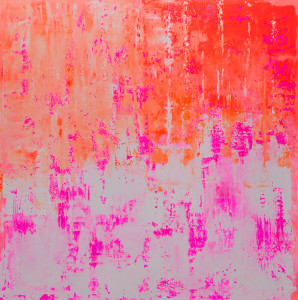Since Paul Delaroche’s 1839 exclamation that “from today painting is dead!” painting has had to fight for our attention. As if trying to restore painting to the top of the ladder this exhibition is titled: The Kick Ass Painting Show. Co-curated by Brigid Noone and Ben Leslie the show includes an ambitious 44 artworks by 24 mostly Adelaide-based painters.
Calling itself ‘kick ass’ sets the bar; they’re ‘fighting words’. Proclaiming greatness but does it deliver? To give the show such a badass title the curators had to come in strong, taking painting (or what we understand as painting) to its extremes. There are moments of brilliance but they are few and far between. Works by James Dodd, Ros Matson, Sam Songailo and Sam Howie show us that painting is not a dried up ‘dead!’ practice. By pushing the limits, these artists’ paintings are ‘out-there’, vigorous, and technically attuned.
Dodd’s ceiling graffiti paintings dotted throughout The Kick Ass Painting Show and his Bike Painting Machine are fun, and free from the discourse of ‘art speak’, which the curators seem keen to avoid. The curators explain their intent of the “paintings to create a resonant installation” through considered placement. Dodd’s work does this by presenting work that is purpose-built for an unconventional location.

Another highlight was the immense canvases by Matson –Untitled (2012) and My Space (2009). The fluorescent palette of Dodd’s works are mimicked in the spectacularly beautiful abstract colour field of Matson’s Untitled painting that drew the viewer closer. Songailo’s (Extended Version) (2012) consists of a mesmerising geometric pattern of black and fluorescent colours. It has been said that people ‘lose themselves’ in his work.
Making the most sense in this exhibition is Sam Howie’s Untitled (2012). Composed of 30 square boards that make one painting, with a textural surface of built up enamel paint – it is a pleasure to view from every angle. Howie is truly a painter’s painter. The success of this painting and Dodd’s ceiling work is that both works ask for more than is traditionally expected from the viewer. For me, these works achieve the ‘cool factor’ that I had been anticipating from The Kick Ass Painting Show.
Aside from these highlights, I couldn’t help but wonder if the curators were serving other interests in their selections. I felt myself questioning inclusions of paintings that weren’t fully resolved or didn’t fit the brief of ‘kick-ass’ only to find out that a number of these artists are studio tenants at Fontanelle.
For The Kick Ass Painting Show to fulfill its title it needed more extreme measures. One option would be to select three awesome painters and let them go nuts, unleashing their artwork on the ceiling, walls and floor. Hinting at this are Dodd’s ceiling panels in psychedelic tones Pacific Riff (reprise) (2012). Another possibility would be a gallery hang of paintings block mounted on the walls to create an overwhelming visual bombardment of works. Instead what we have is a show that sits tentatively between extremes.
To be ‘kick-ass’ you can’t really hold back. In many ways the curators did let loose, including found art and producing an unconventional hang by apparently taking to heart Martin Kippenberger’s challenge that “simply to hang a painting on the wall and say that it’s art is dreadful. The whole network is important!”
The issue is that these placements although quite playful often attach readings to works that the artist may not have intended. At times it seems as if the curators were overtly prescriptive instead of letting the work speak for itself. This is evident in the placement of Thom Buchanan’s Industrious Sinners, Lazy Saints. Buchanan’s compositions of the built environment pride themselves on their perfect perspective. As with all perspective-driven work the composition lines are imperative to the overall immersive effect. Yet this single canvas was hidden in a corner, at the bottom of the wall, just above the skirting board, in the back room. This not only makes it difficult to view the work, it also alters the perspective lines within the composition putting a new reading on the work that goes against the artists’ intention. Is this the role of the curator?
A saving grace is that when the gallery is viewed as a whole it starts to come together, like the way Monet’s paintings need to be viewed from a distance to create a complete picture. The space then begins to resemble a painting with moments of quiet and noise, colour relationships and stylistic pairings, which makes more sense than a themed exhibition on ‘kick-ass’ painting. Perhaps it should have been called Painters Painting Paintings and is better seen as curators being artists creating one painting from many paintings, not curating an exhibition from a selection of work to a certain theme. Let’s say what we mean and mean what we say.
Commissioned art review of The Kick Ass Painting Show at Fontanelle, Adelaide, 24 May – 30 June 2012 written for Artlink Magazine Vol 32 no.3, 2013.
